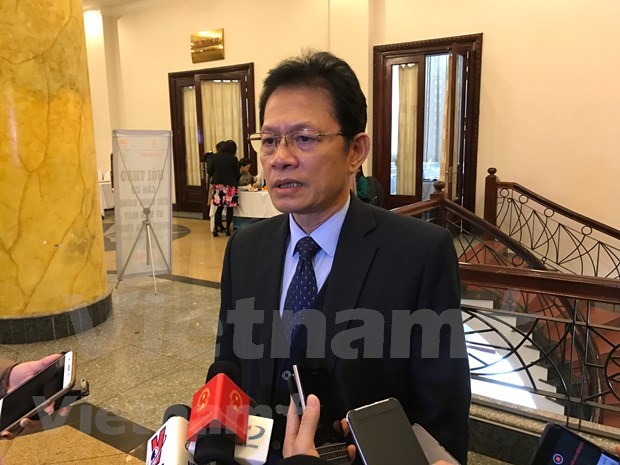MoIT to balance proportion of coal-fueled power to ensure coal supply
 The total amount of domestically-produced coal for electricity production in the long term is estimated at 45-50 million tonnes, which is enough for the generation of 15,000 MW with an output of around 88 billion kWh. (Photo: VietnamPlus)
The total amount of domestically-produced coal for electricity production in the long term is estimated at 45-50 million tonnes, which is enough for the generation of 15,000 MW with an output of around 88 billion kWh. (Photo: VietnamPlus)
Hanoi (VNA) – The Ministry of Industry and Trade (MoIT) will study and balance the proportion of coal-fueled power in the electricity supply structure to put forth mechanisms to ensure sufficient coal for electricity production.
According to the planning scheme, the total amount of domestically-produced coal for electricity production in the long term is estimated at 45-50 million tonnes, which is enough for the generation of 15,000 MW with an output of around 88 billion kWh. However, the MoIT forecast Vietnam is likely to import 85 million tonnes of coal by 2030.
Le Van Luc, Deputy Director of the MoIT’s Electricity and Renewable Energy Authority, talked with reporters about how to ensure the enough supply of coal for electricity production.
Reporter: Could you please unveil the demand for coal of thermoelectricity plants?
Mr Le Van Luc: Vietnam now has 28 thermoelectricity plants with a combined capacity of 18,000 MW. Several coal-fired power plants were built in the 1980s and some others were constructed after 2010, mainly in the northern and central regions. These plants have consumed coal produced in the country, mostly in Quang Ninh province.
In the southern region, three coal-fueled power plants have been or will be put into operation, using coal transported from the North, namely Duyen Hai 1, Vinh Tan 1 and Vinh Tan 2. Two other power plants consuming imported coal are Duyen Hai 3 and Vinh Tan 4. Besides, the expanded Duyen Hai 3 and expanded Vinh Tan 4 plants are preparing for operation. To date, the proportion of domestically-produced coal in electricity production is much higher than imported coal.
According to the revised power development plan VII, the output of coal used for electricity production is estimated at over 130 million tonnes per year by 2030. Of the figure, the amount of domestically-produced coal is only 40 million tonnes a year and the remainder will come from imports. Currently, Vietnam mainly imports coal from Indonesia and Australia. The MoIT is considering the import of coal from other markets such as Russia and South Africa.
Reporter: In the long term, will Vietnam be short of coal for thermoelectricity plants?
Mr Le Van Luc: Thermoelectricity plants consuming imported coal are mainly located in the southern region. These plants have bought coal in patches so that it is difficult to ensure stable, long-term supply sources.
In the coming time, thermoelectricity centres such as Long Phu, Duyen Hai and Song Hau will be put into operation. They have a combined capacity of 12,000 MW and use approximately 36 million tonnes of coal per year.
Excluding the Duyen Hai 1 thermoelectricity plant using domestically-produced coal, the volume of imported coal for the remaining projects amount to 33-34 million tonnes a year. The biggest challenge is to ensure the timely and stable supply of coal amid fluctuations in the world coal market.
To ensure the stable, long-term supply source of coal, the most important factor is capital. If we have large amounts of capital, we will buy coal mines or jointly invest in overseas coal mines with reserves depending on our financial capacity and demand. At the same time, we will cooperate with foreign coal producers to supply coal for domestic thermoelectricity plants.
On the other hand, we should have 5 to 7-year coal supply contracts. If we continue purchasing coal in each shipment or patch we will meet a range of difficulties in the long term due to unstable supply sources and prices.
 Le Van Luc, Deputy Director of the MoIT’s Electricity and Renewable Energy Authority. (Photo: VietnamPlus)
Le Van Luc, Deputy Director of the MoIT’s Electricity and Renewable Energy Authority. (Photo: VietnamPlus)
Reporter: What solutions the Ministry of Industry and Trade has taken to ensure stable coal supply sources for the thermoelectricity plants?
Mr Le Van Luc: Vietnam has yet to sign any contract to jointly exploit coal in foreign countries. We has just studied, surveyed and evaluated overseas markets. When the demand for imported coal soars, the MoIT will propose the government issue mechanisms to help power producers using imported coal sign long-term coal purchase contracts and jointly own overseas coal mines in a bid to ensure the stable supply of coal for domestic electricity production.
The MoIT is preparing to draft a national power development plan for the 2020-2030 period with a vision after 2030. When building the plan, the ministry will take into account and balance primary power sources.
It will look into ensuring coal supply and balancing the proportion of coal-fueled power. Hence, the ministry will define the needed amount of coal and put forth mechanisms to ensure coal supply in line with the plan.
The MoIT will also propose policies to ensure coal supply, the rate of long-term contracts and capital sources to invest in and exploit overseas coal mines.
Reporter: Thank you.-VNA













